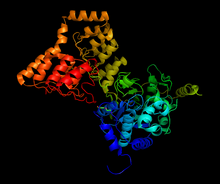| Myosin Light-Chain Phosphatase | |||||||||
|---|---|---|---|---|---|---|---|---|---|
 Structure of complex between PP1 and a portion of MYPT1, generated from 1s70[1] | |||||||||
| Identifiers | |||||||||
| EC no. | 3.1.3.53 | ||||||||
| CAS no. | 86417-96-1 | ||||||||
| Databases | |||||||||
| IntEnz | IntEnz view | ||||||||
| BRENDA | BRENDA entry | ||||||||
| ExPASy | NiceZyme view | ||||||||
| KEGG | KEGG entry | ||||||||
| MetaCyc | metabolic pathway | ||||||||
| PRIAM | profile | ||||||||
| PDB structures | RCSB PDB PDBe PDBsum | ||||||||
| Gene Ontology | AmiGO / QuickGO | ||||||||
| |||||||||
Myosin light-chain phosphatase, also called myosin phosphatase (EC 3.1.3.53; systematic name [myosin-light-chain]-phosphate phosphohydrolase), is an enzyme (specifically a serine/threonine-specific protein phosphatase) that dephosphorylates the regulatory light chain of myosin II:
- [myosin light-chain] phosphate + H2O = [myosin light-chain] + phosphate
This dephosphorylation reaction occurs in smooth muscle tissue and initiates the relaxation process of the muscle cells. Thus, myosin phosphatase undoes the muscle contraction process initiated by myosin light-chain kinase. The enzyme is composed of three subunits: the catalytic region (protein phosphatase 1, or PP1), the myosin binding subunit (MYPT1), and a third subunit (M20) of unknown function. The catalytic region uses two manganese ions as catalysts to dephosphorylate the light-chains on myosin, which causes a conformational change in the myosin and relaxes the muscle. The enzyme is highly conserved[1] and is found in all organisms’ smooth muscle tissue. While it is known that myosin phosphatase is regulated by rho-associated protein kinases, there is current debate about whether other molecules, such as arachidonic acid and cAMP, also regulate the enzyme.[2]
- ^ a b Terrak, Mohammed; Kerff, Frederic; et al. (June 17, 2004). "Structural Basis of Protein Phosphatase 1 Regulation". Nature. 429 (6993): 780–4. Bibcode:2004Natur.429..780T. doi:10.1038/nature02582. PMID 15164081.
- ^ Hartshorne, DJ; Ito, M (May 1998). "Myosin Light Chain Phosphatase: Subunit Composition, Interactions and Regulation". J Muscle Res Cell Motil. 19 (4): 325–41. doi:10.1023/A:1005385302064. PMID 9635276. S2CID 27448238.